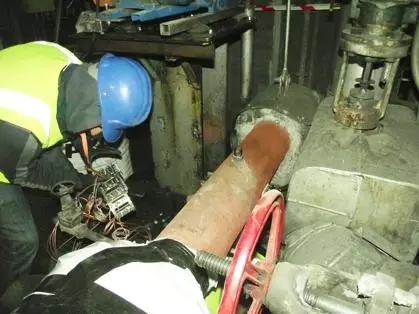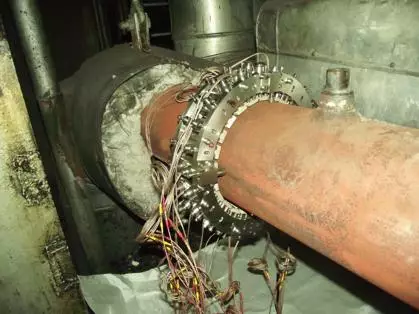HotScan: Ultrasonic system for inspection and structural health of high temperature superheated steam pipes
Background
Long range ultrasonic system for continuous in-service inspection and structural health of high temperature superheated steam pipes in power generation plant with 100 per cent coverage.
High temperatures and pressures in superheated steam pipes in power plants can lead to the formation of flaws and defects due to material degradation mechanisms such as corrosion, creep and fatigue over time.


Objectives
The overall aim of the Hotscan project was to develop high temperature ultrasonic guided wave transducers to enable inspection and monitoring to be carried out on high temperature pipe work, and as a result increase the safety and efficiency of power plants and oil refineries. The specific objectives of the research were:
- To improve the current transducers to enable UGW testing at temperatures up to 250C.
- To develop transducers that can operate at temperatures up to 580C.
- To develop a high temperature collar array to enable UGW testing on pipes in laboratory and field conditions.
- To investigate defect detection capability of the developed transducers at elevated temperatures in laboratory conditions, and deploy the developed transducers and the collar array in real life conditions.
The main objectives of this research have been achieved by developing UGW transducers that can withstand elevated temperatures. However, further work is still required for these transducers to be used in commercial UGW systems, including assessing the feasibility of defect detection using LN transducers at up to 580°C, and testing the transducer collar array in a power plant at up to 250°C.
Benefits
The research has achieved significant advances towards enabling UGW inspection and condition monitoring of high temperature pipe work by developing transducers that can operate at elevated temperatures.
Project Partners
- Plant Integrity Ltd
- Cereteth
- Vermon
- PolKon Badania
- TecniTest NDT
- Inetec
- Brunel University London
For more information, please visit the HotScan website.
Meet the Principal Investigator(s) for the project

Professor Tat-Hean Gan - Professional Qualifications CEng. IntPE (UK), Eur Ing BEng (Hons) Electrical and Electronics Engg (Uni of Nottingham) MSc in Advanced Mechanical Engineering (University of Warwick) MBA in International Business (University of Birmingham) PhD in Engineering (University of Warwick) Languages English, Malaysian, Mandarin, Cantonese Professional Bodies Fellow of the British Institute of NDT Fellow of the Institute of Engineering and Technology Tat-Hean Gan has 10 years of experience in Non-Destructive Testing (NDT), Structural Health Monitoring (SHM) and Condition Monitoring of rotating machineries in various industries namely nuclear, renewable energy (eg Wind, Wave ad Tidal), Oil and Gas, Petrochemical, Construction and Infrastructure, Aerospace and Automotive. He is the Director of BIC, leading activities varying from Research and development to commercialisation in the areas of novel technique development, sensor applications, signal and image processing, numerical modelling and electronics hardware. His experience is also in Collaborative funding (EC FP7 and UK TSB), project management and technology commercialisation.
Related Research Group(s)
Brunel Innovation Centre - A world-class research and technology centre that sits between the knowledge base and industry.
Partnering with confidence
Organisations interested in our research can partner with us with confidence backed by an external and independent benchmark: The Knowledge Exchange Framework. Read more.
Project last modified 21/04/2021